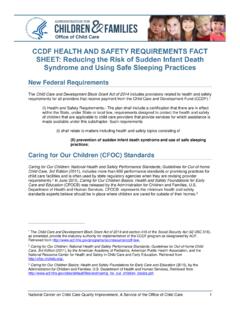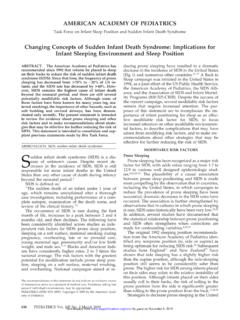Transcription of Sudden Unexpected Infant Death (SUID) and Sudden Infant ...
1 Sudden Unexpected Infant Death ( suid ) and Sudden Infant Death syndrome (SIDS) Each year in the United States, there are approximately 4,000 cases of Sudden Unexpected Infant Death ( suid ). These deaths occur among infants aged 1-12 months and have no immediately obvious cause. The three commonly reported types of suid are: SIDS Unknown cause Accidental suffocation and strangulation in bed (ASSB) According to the Centers for Disease Control and Prevention and the National Center for Health Statistics, National Vital Statistics System, Compressed Mortality File, in 2011 the majority of Sudden Unexpected Infant Death cases (56%) were categorized as Sudden Infant Death syndrome , followed by unknown cause (26%), and accidental suffocation and strangulation in bed (18%). The CDC/NCHS National Vital Statistics System outlines the trends in Sudden Unexpected Infant Death rates in the United States from 1990 through 2011.
2 The trends indicate: Sudden Infant Death syndrome (SIDS) rates declined considerably from deaths per 100,000 live births in 1990 to deaths per 100,000 live births in 2001. Unknown cause Infant mortality rates remained unchanged from 1990 through 2011. In 2011, the unknown cause mortality rate in infants was 22 deaths per 100,000 live births. Accidental suffocation and strangulation in bed (ASSB) mortality rates remained unchanged until the late 1990s. Rates started to increase beginning in 1998 and reached the highest rate at deaths per 100,000 live births in 2008. The combined suid Death rate (which includes SIDS, unknown cause, and ASSB) declined considerably following the release of the American Academy of Pediatrics safe sleep recommendations in 1992, the initiation of the Back to Sleep campaign in 1994, and the release of the Sudden Unexplained Infant Death Investigation Reporting Form in 1996.
3 However, the total suid Death rate has not decreased significantly since 1999. CDC/NCHS data shows Sudden Unexpected Infant Death ( suid ) rates (which include Sudden Infant Death syndrome , unknown cause, and accidental suffocation and strangulation in bed) by race/ethnicity in the United States from 2007 to 2010. That data indicates that suid Death rates per 100,000 live births for American Indian/Alaska Native ( ) and non-Hispanic black infants ( ) were more than twice those of non-Hispanic white infants ( ). suid Death rates per 100,000 live births were lowest among Hispanic infants ( ) and Asian/Pacific Islander infants ( ). For more information regarding Sudden Unexpected Infant Death ( suid ) and Sudden Infant Death syndrome (SIDS), please see the Centers for Disease Control and Prevention website link at For further information regarding this article, please contact Dr.
4 Karen Kuehn Howell at the Center for Maternal Substance Abuse and Child Development (MSACD), Emory University School of Medicine, Department of Psychiatry and Behavioral Sciences, 12 Executive Park Drive NE, Atlanta, Georgia, 30329. You can also phone us at 404-712-9829 or visit our website at The Center for Maternal Substance Abuse and Child Development is funded by the Georgia Department of Behavioral Health and Developmental Disabilities










